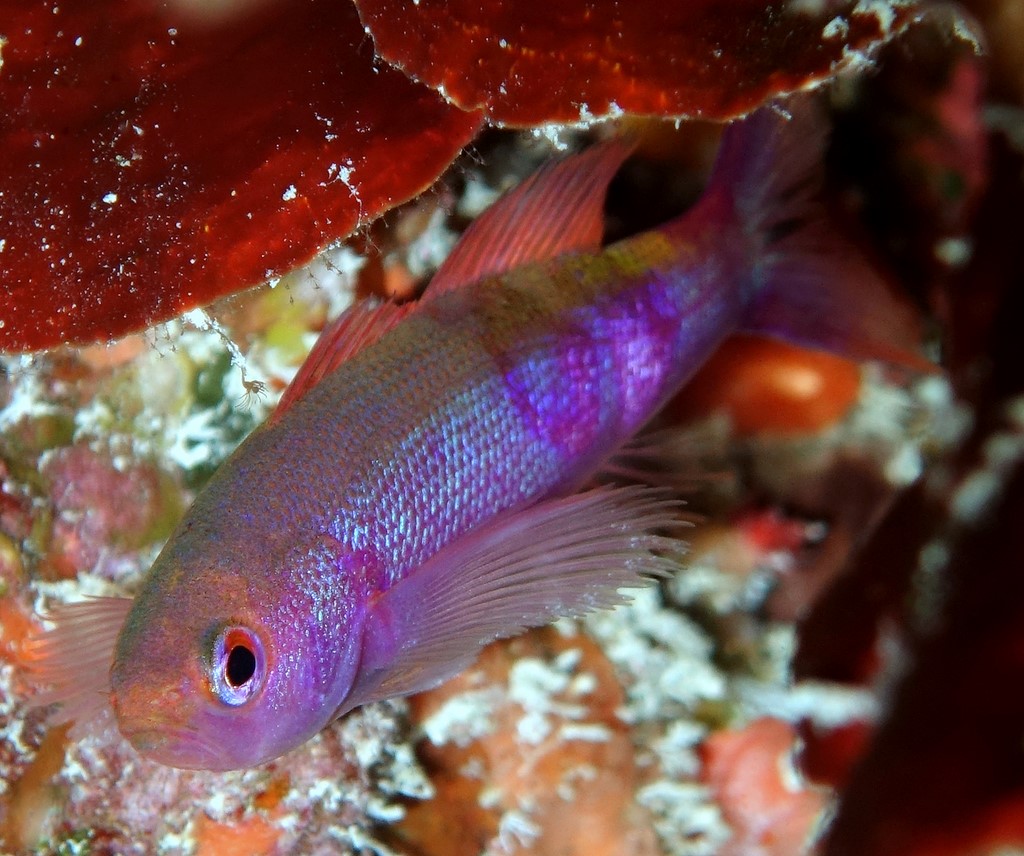LUZONICHTHYS WAITEI - (FOWLER, 1931)
Picture courtesy of: Alain Daoulas
Actinopterygii (Gigaclass) > Actinopteri (Class) > Teleostei (Subclass) > Perciformes (Order) > Percoidei (Suborder) > Anthiadidae (Family) > Luzonichthys (Genus)
Pygmy basslet, Waite's splitfin, Magenta slender anthias, Purple pygmy basslet, Magenta splitfin, Minamihanadai, ミナミハナダイ, 双鳍吕宋花鮨,
Synonymes
Luzonichthys addisi (Smith, 1955)
Luzonichthys robustus (Fourmanoir, 1977)
Mirolabrichthys waitei (Fowler, 1931)
Naurua addisi (Smith, 1955)
---------------------------
Description
Dorsal spines (total): 10; Dorsal soft rays (total): 15-17 (usually: 16), the two dorsal fins separate; Anal spines: 3; Anal soft rays: 7; Pectoral fin rays: 17-21 (usually: 19); Gill rakers: 7-10 + 19-22; Lateral line scales: 51-59; Caudal fin rays: 15 (8 + 7); Pelvic fin rays: 26 (11 + 15). Body slender: 3.3-3.8 in SL; Relatively long paired fins, pectorals: 3.2-3.45 and pelvics: 3.7-4.7 in SL. Papillae present on posterior margin of orbit; Two opercular spines; Fourth dorsal spine lognest, but not prolonged; Caudal fin deeply forded, often short filaments on lobes. The least depth: 2.33-2.55 in HL; Snout length: 3.7-4.1 in HL; Scales on snout extending in front of anterior nostrils; Pelvic fin short: 1.3-1.5 in HL. Head length: 3.0-3.6 in SL. Max. length : 7.0 cm TL, 5.5 cm SL. Depth range: 1 - 55 m, usually: 1 - 35 m.
Actinopterygii (Gigaclass) > Actinopteri (Class) > Teleostei (Subclass) > Perciformes (Order) > Percoidei (Suborder) > Anthiadidae (Family) > Luzonichthys (Genus)
Pygmy basslet, Waite's splitfin, Magenta slender anthias, Purple pygmy basslet, Magenta splitfin, Minamihanadai, ミナミハナダイ, 双鳍吕宋花鮨,
Synonymes
Luzonichthys addisi (Smith, 1955)
Luzonichthys robustus (Fourmanoir, 1977)
Mirolabrichthys waitei (Fowler, 1931)
Naurua addisi (Smith, 1955)
---------------------------
Description
Dorsal spines (total): 10; Dorsal soft rays (total): 15-17 (usually: 16), the two dorsal fins separate; Anal spines: 3; Anal soft rays: 7; Pectoral fin rays: 17-21 (usually: 19); Gill rakers: 7-10 + 19-22; Lateral line scales: 51-59; Caudal fin rays: 15 (8 + 7); Pelvic fin rays: 26 (11 + 15). Body slender: 3.3-3.8 in SL; Relatively long paired fins, pectorals: 3.2-3.45 and pelvics: 3.7-4.7 in SL. Papillae present on posterior margin of orbit; Two opercular spines; Fourth dorsal spine lognest, but not prolonged; Caudal fin deeply forded, often short filaments on lobes. The least depth: 2.33-2.55 in HL; Snout length: 3.7-4.1 in HL; Scales on snout extending in front of anterior nostrils; Pelvic fin short: 1.3-1.5 in HL. Head length: 3.0-3.6 in SL. Max. length : 7.0 cm TL, 5.5 cm SL. Depth range: 1 - 55 m, usually: 1 - 35 m.
Color
A fish with a pale yellowish upper head and back that fades to lavender pink below, with bright yellow caudal-fin lobes, and a dark pink margin on the dorsal fin and lower edge of caudal fin. The body color of females is monochromatic, whereas males have a purplish second half of the body.
Etymology
Luzonichthys: named for Luzon Island, Philippines, type locality.
waitei: named in honor of “distinguished” Australian zoologist Edgar R. Waite (1866-1928), for his many contributions to ichthyology.
Original description: Mirolabrichthys waitei Fowler, 1931 - Type locality: Port Maricaban, Luzon Island, Philippines.
Distribution
Biology
Usually in groups on outer reef slopes. Most commonly occurs in shallow water and most likely seen by divers. Forms dense aggregations that feed on zooplankton. Aquarium fish. Capable of changing sex.
Similar species
Luzonichthys whitleyi (Smith, 1955) - Reported from New Caledonia. A small slender splitfin with bright yellow on the snout, top of the head and back, lavender pink elsewhere.
Luzonichthys williamsi (Randall & McCosker, 1992) - Reported from New Caledonia.
Last update: 10, April 2023
Luzonichthys: named for Luzon Island, Philippines, type locality.
waitei: named in honor of “distinguished” Australian zoologist Edgar R. Waite (1866-1928), for his many contributions to ichthyology.
Original description: Mirolabrichthys waitei Fowler, 1931 - Type locality: Port Maricaban, Luzon Island, Philippines.
Distribution
Indo-West Pacific: Seychelles, Aldabra (Seychelles), Saint Brandons Shoals (Cargados Carajos), Agalega Islands (Mauritius), western Mascarenes (La Pérouse Seamount and La Réunion) and Chagos Archipelago, east to Philippines and Papua New Guinea, north to Japan, south to northern Australia, Solomon Islands and New Caledonia.
Biology
Usually in groups on outer reef slopes. Most commonly occurs in shallow water and most likely seen by divers. Forms dense aggregations that feed on zooplankton. Aquarium fish. Capable of changing sex.
Similar species
Luzonichthys whitleyi (Smith, 1955) - Reported from New Caledonia. A small slender splitfin with bright yellow on the snout, top of the head and back, lavender pink elsewhere.
Luzonichthys williamsi (Randall & McCosker, 1992) - Reported from New Caledonia.
Last update: 10, April 2023
